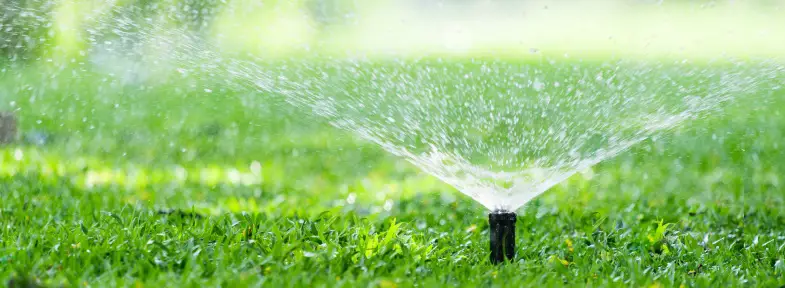With the increase in global warming, what do you do on a hot afternoon when you’ve been out under the sun, and you’re sweaty and uncomfortable? Standing under the shower with the temperature at cold or having a chilled glass is, of course, the answer you’ll most likely give.
Well, how about the plants in your lawn? I mean they live under the sun, there’s no covering to shield them from the harsh sun. Don’t you think they need water? What if you’re occupied with other vital needs? How do you ensure your plants get the much-needed water?
What Is Irrigation and Irrigation System?
Irrigation is the system of artificially supplying plants with controlled proportions of water. In areas where there is lesser rainfall, irrigation is vital for the survival of plants.
An irrigation system is the various methods employed in the automatic provision of water to plants, grass, flowers, shrubs, and trees, so they flourish. Different modes of irrigation include; surface irrigation, sprinkler irrigation, drip irrigation, blended irrigation, etc.
Why is Irrigation Important?
An essential part of lawn maintenance is irrigation. There are several reasons why your plants, grass, flowers, need irrigation, a few of them include:
- All plants need water to grow, without water, your lawn plants will wither and die. Irrigation ensures that your lawn gets a steady supply of water at the appropriate proportion.
- All plants require water for photosynthesis to take place. Photosynthesis is the method through which plants generate their food for adequate growth, development, and in the cases of fruit plants, eventually generation of fruits and vegetables for consumption. Photosynthesis happens when there is water, and irrigation provides that need.
- Irrigation is essential to maintain a balance in soil nutrients. In providing your lawn with water, you do not want to oversupply the grasses and plants with more water than is needed.
Overwatering your yard can result in the soil becoming too dense and compacted, which may lead to loss of soil nutrients. With an irrigation system, automated or controlled distribution of water is provided, and you need not fear for too much water supply. A carefully monitored and regulated amount of water is supplied to your yard.
- Irrigation systems can be automated. This means that once it’s set appropriately, you can save a great deal of time. You’ll also save water and utility bills as your plants will only get the right amount of water they need to thrive.
- I’m quite sure you don’t want weeds in your garden. With a more targeted sprinkler irrigation system, you can have water distributed to the roots of the plants that you want in your lawn while depriving the weeds of water.
This way, you get to stop the weeds from thriving. Likewise, by restricting the amount of water that is showered onto the top of the lawn, you can curtail the probability of any leaf diseases.
What Are The Different Types of Irrigation System and Their Uses?
Irrigation extends to almost all types of agriculture, however, in the case of your lawn, or garden, some of the following are the common types of irrigation systems:
#1. Sprinkler Irrigation System
Sprinkler irrigation systems preserve water, stops during rain and has a high probability of reaching all plants and grass on your lawn. To use the sprinkler method, you split the lawn into zones, set sprinkler heads according to the water need of each zone, and then connect the sprinkler system to a timer and sensor, and the yard waters itself.
Sprinkler heads can either sit above the ground or come up when the system initializes. They can maintain a static structure suitable for particular zones, or distribute water back and forth or even in circles over the lawn.
A possible drawback of sprinkler irrigation systems is that they may waste excess water as a result of evaporation and spray, particularly when it is breezy. They might not be the acceptable option for a steep slope or if your lawn has relatively sandy or clay-based soils.
#2. Surface Irrigation System
This is the most popular method of irrigation. It encompasses irrigating the soil’s surface and letting the water to penetrate under the earth. Surface irrigation is soaking with a hose and a sprinkler.
Though, surface irrigation is strenuous and wasteful. The water is not regulated and controlled. Some plants receive water when they do not require it, while those in farther locations from the hose, do not get enough. Due to the stress involved with this method, the plants may not receive enough water to grow healthy.
#3. Drip Irrigation System
Drip, also called trickle irrigation, is an ideal method for regions with varied shrubs, trees, flowers, and grass, all needing distinct quantities of water. Low-volume drip irrigation systems allow you to customize water delivery to prevent plant loss and water wastage.
The drip irrigation system has drippers/emitters, which drop water directly towards the plant’s root to establish the ideal moisture level. They work well in any topography.
#4. Blended Irrigation System
Blend irrigation system blends both the drip and sprinkler systems of irrigation to provide the most efficient and cost-effective irrigation for your lawn.
Blend irrigation systems feature refined, programmable regulators to regulate multiple zones and initiation moments. Regulators and valves also monitor the weather and control water pressure to supply a steady flow despite the variations on your property.
How Much Water Should Your Irrigation System Use?
- For your lawn, irrigate profoundly but infrequently to stimulate deep roots. The cue to irrigating your grass is to supply sufficient water to soak down to the bottom of the roots. The quantity depends on the soil type. Nonetheless, it is advisable to apply no more than one inch of water every time, which is ample to saturate the soil to between six and ten inches.
- Always gauge your sprinkler output. Unknowingly, you could quickly sprinkle up to 400 gallons of water in one hour, and you’re left with an over-watered lawn. Use the following steps to test your sprinkler’s output so you can regulate your watering time:
- Position six to eight shallow, flat-bottomed containers (tuna or cat food, etc.), at scattered locations around your lawn.
- Put on your sprinklers for about 15 minutes.
- Take the measurement of the depth of water in each container using a ruler. Add all the numbers and then divide by the number of boxes to get at the average output.
- This average number constitutes your sprinkler number. It is the average amount of water your sprinklers supply in 15 minutes.
- After you’ve calculated your sprinkler supply number, you then calculate the length of time to run your sprinkler. A secure method is given in the chart below, find your sprinkler number, and find the corresponding watering time.
Sprinkler Run Time to Apply 1 Inch
| Sprinkler Number | 0.2 | 0.3 | 0.4 | 0.5 | 0.6 | 0.7 | 0.8 | 0.9 | 1.0 |
| Watering Time(in Minutes) | 75 | 50 | 37 | 30 | 25 | 22 | 19 | 16 | 15 |
I’m sure this an easy step to follow. You can now set your sprinkler timer and irrigate your lawn for the appropriate number of minutes. After irrigation, wait an hour and nudge a spade or long screwdriver into the soil to check if you’ve saturated the earth to the proper depth.
When adequately watered, the shovel will glide effortlessly through the wet ground, but it will be challenging to push through if the oil is dry.
Please note that if you use your sprinkler for the exact number of minutes, yet water pools or runs off your lawn, then you have to divide your irrigating time into two or more rounds. Wait an hour between shots for the water to soak in.
Conclusion
You understand by now that irrigation is vital to the beauty of your lawn. You also know the way to measure the amount of water your irrigation should use. Also note, irrigation should only take place only when your soil is suffering from a low water supply.
To know when the soil is parched, walk on it, and if your footprints on the lawn are visibly distinct or the grass doesn’t spring back after you, then you need to water. Maintain the application of one inch of water including rainfall, each time you spray, then once a week is generally suitable to retain your lawn’s freshness throughout the summer.

